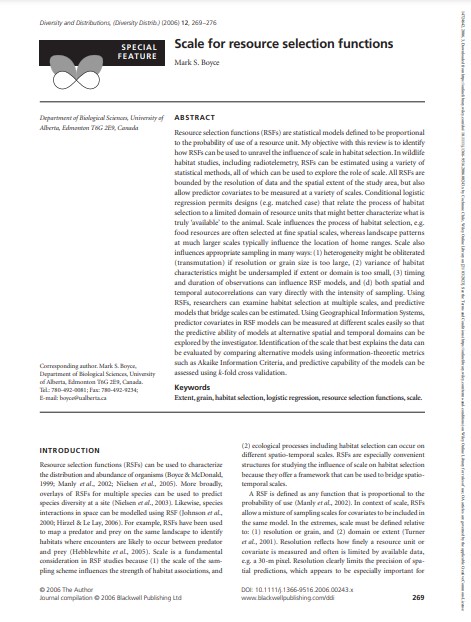Scale for resource selection functions
Bosque Modelo:
Foothills
Temática:
Conservación
Tipo de documento:
Artículo científico
Resumen
Resource selection functions (RSFs) are statistical models defined to be proportional to the probability of use of a resource unit. My objective with this review is to identify how RSFs can be used to unravel the influence of scale in habitat selection. In wildlife habitat studies, including radiotelemetry, RSFs can be estimated using a variety of statistical methods, all of which can be used to explore the role of scale. All RSFs are bounded by the resolution of data and the spatial extent of the study area, but also allow predictor covariates to be measured at a variety of scales. Conditional logistic regression permits designs (e.g. matched case) that relate the process of habitat selection to a limited domain of resource units that might better characterize what is truly ‘available’ to the animal. Scale influences the process of habitat selection, e.g. food resources are often selected at fine spatial scales, whereas landscape patterns at much larger scales typically influence the location of home ranges. Scale also influences appropriate sampling in many ways: (1) heterogeneity might be obliterated (transmutation) if resolution or grain size is too large, (2) variance of habitat characteristics might be undersampled if extent or domain is too small, (3) timing and duration of observations can influence RSF models, and (d) both spatial and temporal autocorrelations can vary directly with the intensity of sampling. Using RSFs, researchers can examine habitat selection at multiple scales, and predictive models that bridge scales can be estimated. Using Geographical Information Systems, predictor covariates in RSF models can be measured at different scales easily so that the predictive ability of models at alternative spatial and temporal domains can be explored by the investigator. Identification of the scale that best explains the data can be evaluated by comparing alternative models using information-theoretic metrics such as Akaike Information Criteria, and predictive capability of the models can be assessed using k-fold cross validation.
Información Bibliográfica
Autor:
Boyce, MS.
Revista:
Diversity and Distributions
Año:
2006
N°:
-
País :
Canadá
Páginas:
269 - 276
Volumen:
12
Idioma:
Ingles
Palabras claves
https://onlinelibrary.wiley.com/doi/pdf/10.1111/j.1366-9516.2006.00243.x





